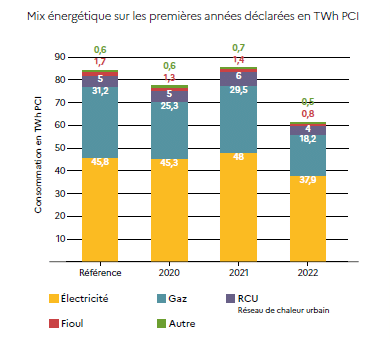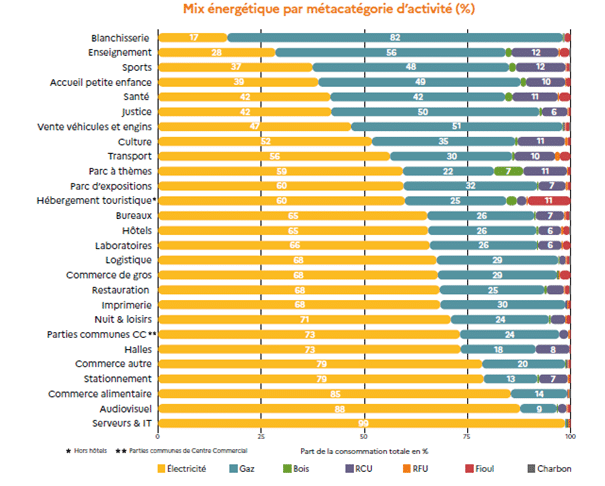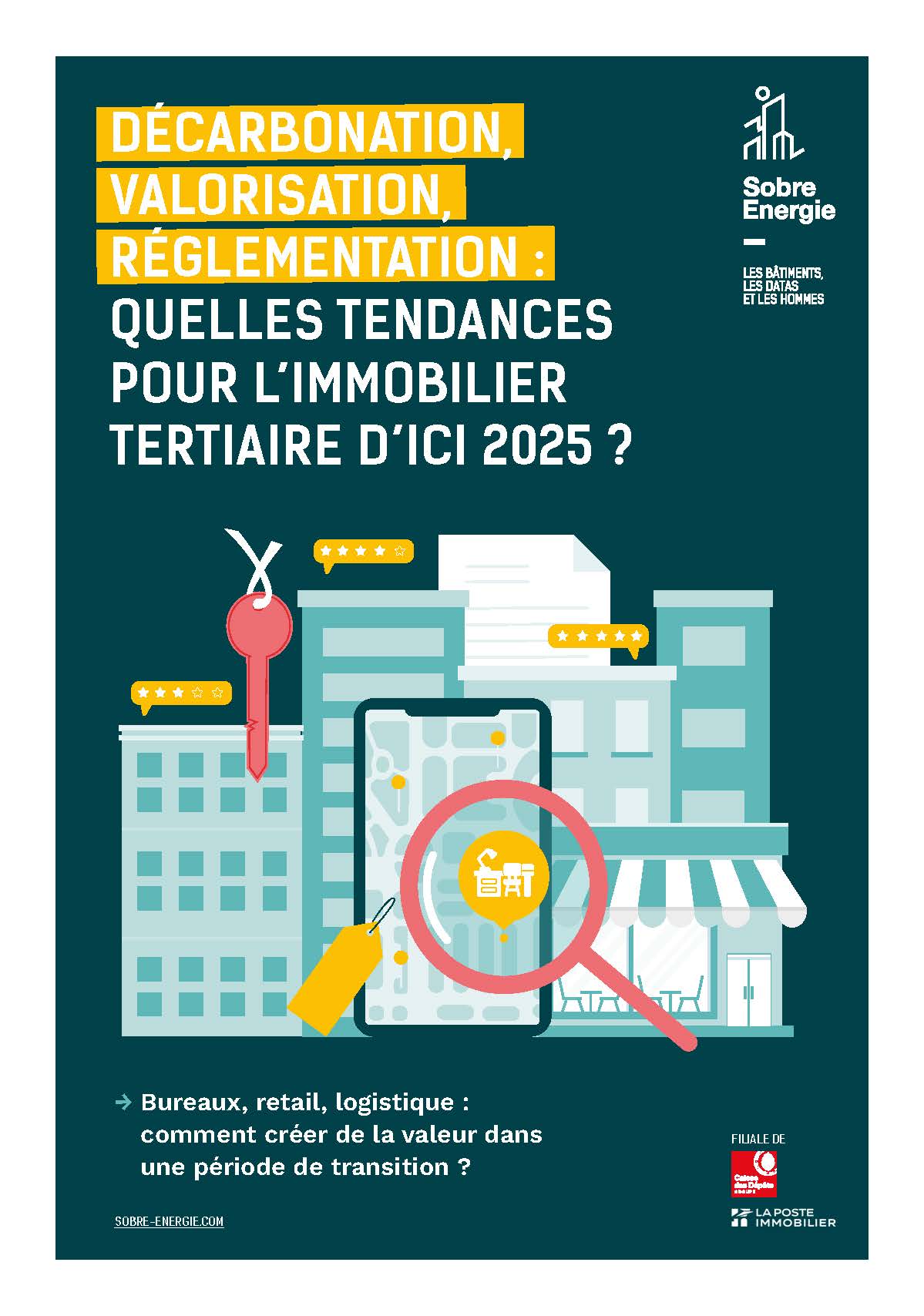The evolution of the energy mix of tertiary buildings in France, which includes sectors such as offices, schools, and businesses, reflects changes in energy policies, regulatory advances and increasing environmental requirements.
This sector, historically energy-intensive, has seen its consumption evolve significantly, particularly with the transition to more sustainable heating methods, the reduction in the use of fossil fuels, and the rise of regulations such as the Tertiary Decree.
The evolution of the energy mix in the tertiary sector
According to a recent study published by ADEME on the energy performance of the French tertiary sector* (around 1 billion m²), 57% of those subject to them carried out their consumption declaration procedures on the ADEME OPERAT platform.
Among them, the evolution of the energy mix is notable:

Natural gas
Gas has historically been a major source for heating tertiary buildings. However, its share tends to gradually decrease in favor of more ecological solutions. Compared to the reference year declared on OPERAT, gas consumption fell by 40% in 2022 (from 31.2 TWh to 18.2 TWh). Correlated with “the context of an accentuated energy crisis at the start of 2022, marked by tensions over gas supplies and the associated rise in prices, as well as a particularly mild winter. ".
The entry into force of the Tertiary Eco Energy Decree, since 2021, and the recent APER law, which encourages the promotion of self-consumption of renewable energies, also explains this trend.
However, the evolution of the energy mix varies depending on the category of tertiary activity. Thus, in educational buildings (schools, middle schools, high schools, universities) which are often old and energy-intensive, the share of gas is still the majority (56%), unlike, for example, offices (26%) or businesses (less than a quarter of the energy mix):

Electricity
Electricity, initially used mainly for lighting and IT equipment, has seen its share increase, particularly with the development of electric heating solutions, such as heat pumps. Thus the share of electricity in the tertiary energy mix in 2022 amounts to 62%, compared to 54% in the average declared reference year.
Overall electricity consumption is decreasing due to the impact of successive recent crises: inflation in energy prices and the first effects of the sobriety plan put in place at the end of 2022 by the government.
Evolution of heating methods
Heating represents a major part of energy consumption in tertiary buildings (more than 50% on average).
Here are the main developments observed:
- Transition to heat pumps: Heat pumps, which use energy from air, water or ground to heat buildings, are increasingly adopted. They offer very high energy efficiency compared to traditional gas or oil boilers. This technology also helps reduce greenhouse gas emissions, thereby contributing to national climate goals.
- Gradual abandonment of fuel oil: Fuel oil, once widely used, is in sharp decline due to its high environmental impact. Tertiary buildings tend to replace these old boilers with more efficient and less polluting systems, such as gas condensing boilers or heat pumps. Its level of consumption has been divided by 2 according to Ademe statistics.
- Development of urban heating: Heat networks, which can operate from renewable energy sources (biomass, geothermal) or recovery, are developing in urban areas. This collective heating method is particularly suitable for large tertiary complexes, offering a solution that is both efficient and ecological.
How to comply with the Tertiary Decree?
Promulgated as part of the Elan law in 2018, the Tertiary Decree requires owners and operators of tertiary buildings to reduce their energy consumption significantly in the years to come. This objective is part of a broader approach to reducing greenhouse gas emissions and energy transition in France.
The obligations of the Tertiary Decree are twofold:
- Energy consumption reduction objectives: The buildings concerned must reduce their final energy consumption by 40% by 2030, 50% by 2040, and 60% by 2050 compared to a reference year chosen between 2010 and 2019.
- Flexibility and continuous improvement trajectory: Operators can choose between two approaches to achieve these objectives: either a percentage reduction in their consumption compared to a reference year, or reaching an absolute threshold of energy consumption by type of building. This flexibility makes it possible to adapt efforts according to the initial state of the building and the technical means available.
The impact of the Tertiary Decree is major on the evolution of the energy mix of tertiary buildings. Managers are pushed to invest in energy renovations, modernize their equipment and integrate renewable energy production solutions such as photovoltaic solar.
To prioritize this work, the key tool is the energy audit: energy audits on our SAAS Data MARC software allow you to simulate the implementation of a predefined scenario or compose your bouquet of actions with financial projections and savings. energies, according to your ROI and objectives linked to the Tertiary Decree.
At Sobre Energie, our digital audits are integrated into our energy management platform, within a specific module.
Towards a greener and more resilient energy mix
The future of the energy mix of tertiary buildings in France is clearly part of an ecological transition logic. Buildings must become less and less energy-intensive while decarbonizing by increasing their share of renewable energies.
- Development of self-consumption: More and more tertiary buildings are being equipped with solar panels to reduce their dependence on the network and maximize the use of local renewable energy.
- Use of digital tools: Energy management tools (BMS - Technical Building Management) make it possible to optimize energy consumption in real time, by adjusting heating, lighting and ventilation needs according to building occupancy .
In conclusion, the evolution of the energy mix of tertiary buildings in France is characterized by a transition towards more sustainable energy sources, a continuous improvement in energy efficiency, and an increasingly demanding regulatory framework. These transformations are essential to respond to climate challenges while guaranteeing the comfort and economic performance of tertiary buildings.
